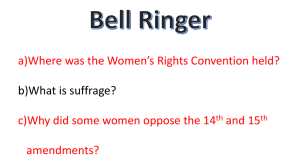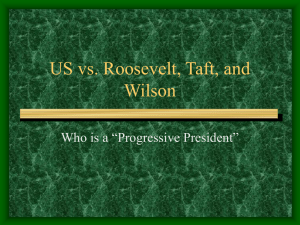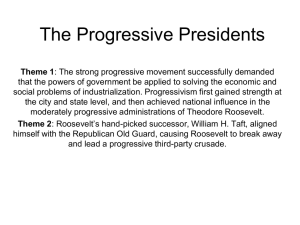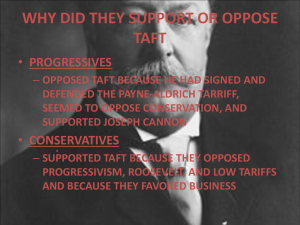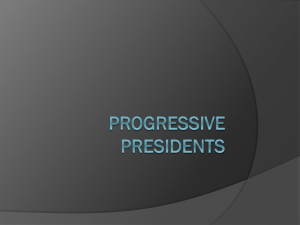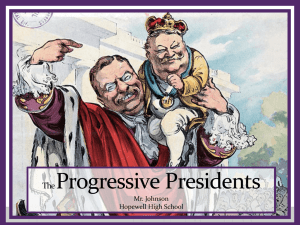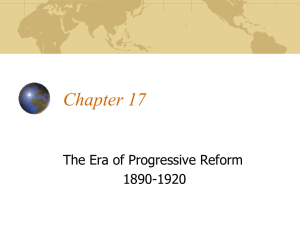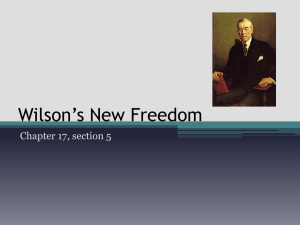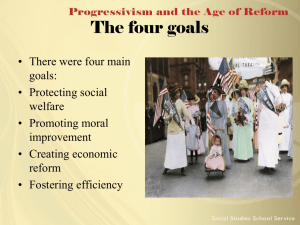Chapter 11: Powerpoint
advertisement
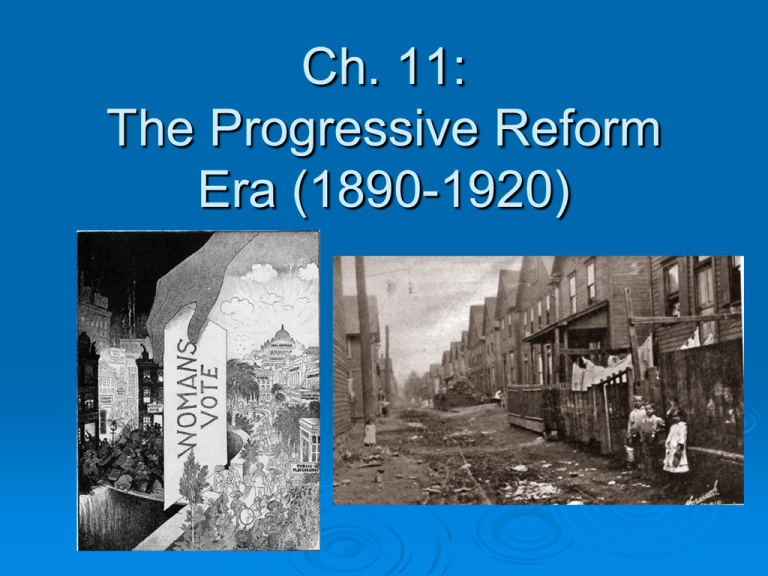
Ch. 11: The Progressive Reform Era (1890-1920) Section 1: Origins of Progressivism The early 20th century brought a series of domestic reforms, known as progressivism. Roots of 20th Century Reform Populism: William Jennings Bryan Social Gospel Movement Prohibition Electoral reforms Settlement houses Unlike Populism which came from the rural West, 20th century progressivism comes primarily from within cities. Goals and Beliefs Government should… Be accountable to its citizens. Curb the power and influence of wealthy interests. Be given expanded powers to help improve the life of its citizens. Become more efficient and less corrupt. Henry George Early reformer and writer. Wrote Progress and Poverty, in 1879. Believed poverty arose when wealthy people bought land and held it. Proposed land tax. Edward Bellamy Newspaper editor, wrote Looking Backward in 1888. A man goes into hypnosis in 1887 and wakes up in the year 2000. Waking up in 2000, he finds the U.S. to be transformed. For many Americans, the book represented what could be. The Muckrakers Journalists played the role of alerting the public to wrongdoing in politics and business. Theodore Roosevelt called these writers muckrakers. A muckrake is a rake used to clean manure and hay out of stables. Upton Sinclair: The Jungle Upton Sinclair wrote The Jungle Exposed the public to the horrible working and sanitation conditions of the meatpacking industry. Prompted the creation of the Food and Drug Administration (FDA). The Jungle “It seemed they must have agencies all over the country, to hunt out old and crippled and diseased cattle to be canned. There were cattle which had been fed on ‘whisky-malt,’ the refuse (garbage) of the breweries, and had become what the men called ‘steerly’which means covered with boils… It was stuff such as this that made the ‘embalmed beef’ that killed several times as many U.S. soldiers as all the bullets of the Spaniards (in SpanishAmerican War).” -Upton Sinclair, The Jungle, 1906 The Labor Movement Unions, although stifled by business leaders, continued to grow into the 1900s. Fought for better working conditions and higher wages. Socialists The Progressive Era saw a rise in the popularity of socialism. Socialism- an economic and political philosophy/system favoring government control of property and income. Many promoted socialist ideas as a means of more evenly distributing wealth. Socialists advocated government ownership of major American industries (oil, steel, etc.). Socialist Party of America Founded in 1901. By 1912 the party had won more than 1,000 government offices. Many progressives thought socialism too extreme and merely wanted to reform the current system, ridding the government of corruption and improving the quality of life for the lower class. Women’s Groups Women rise to new levels of civic activism. Women founded the National Consumers’ League (NCL). NCL investigated the conditions under which goods were made and sold. Much of women’s activism came to be focused around one primary issue, women’s right to vote. Florence Kelley A leader in labor reform. Worked for with Jane Addams at the Hull House in Chicago. Government asked Kelley to help investigate local labor conditions. Based on her work, Illinois passed a law prohibiting child labor and regulated sweatshop conditions. Focused on outlawing child labor and worker protection. Mary Harris “Mother” Jones Irish immigrant, lost her husband and four children in a yellow fever epidemic in Tennessee. Established a dressmaking business, lost it all in the Great Chicago Fire. Became passionate about labor reform. Traveled around the country organizing labor unions, particularly in the mines in West Virginia and Colorado. Spokesperson for unions, founded the International Workers of the World (IWW). Resistance to Progressive Reforms Many resisted progressives attempt to reform society. Sought to increase government involvement in housing, the workforce, healthcare, and even entertainment. Some resisted the idea of increase government control. Even some poor families, who progressives were trying to help, sometimes resisted ideas like banning child labor, which they depended on to survive. Section 2: Progressive Legislation The push for reform gave way to new legislation during the Progressive Era. Expanded Role for Government Progressives believed that government ought to increase its responsibility for the welfare of people. Advocated a “safety net” for people. Unemployment benefits Accident and health insurance Social security. Municipal Reforms Municipal = City/Local Municipal reforms aimed at ending corruption within cities. Attacked political machines like Tammany Hall (Boss Tweed) in favor of educated, professional leadership. City Reforms Some cities changed their structure of government. Many city governments began to take over control of utilities (water, gas, and electric) to break up monopolies. Some cities offered new welfare systems New public parks, baths, and work-relief programs. State Reforms Voters gained more direct influence in lawmaking and in choosing candidates. Formerly, party leaders often handpicked candidates for office. States began adopting direct primaries for state offices. In a direct primary, citizens can select their own nominee for an upcoming election. Power to Voters Many states adopted… Initiatives- allows voters to put a proposed law directly on a future ballot by collecting voters’ signatures on a petition. Referendum- allows voters to approve or reject a law passed by the legislature. Recall- allows voters to remove public officials from office before the next election. 17th Amendment Prior to political reforms, US senators were picked by each state’s legislature. In 1913, the 17th Amendment required the direct election (voter chosen) of senators. Reforms in the Workplace State reformers worked to curb workplace hazards. Many states established labor departments to regulate working conditions. Businesses resisted new government regulation, believing it to be unconstitutional. Muller v. Oregon In Muller v. Oregon, limited female laundry workers to working 10 hours a day. Using scientific evidence they successfully argued that long work hours negatively affected women’s health. Robert La Follette Wisconsin governor, Robert La Follette, was one of the most determined Progressives in U.S. politics. “Fighting Bob” tried to clean up government and produce social welfare reforms. Served as Wisconsin governor then as U.S. Senator. Ran as the Progressive Party’s candidate for President in 1924, and earned one sixth of the vote. Theodore Roosevelt’s “Square Deal” In 1902, the United Mine Workers went on strike. Mine owners refused to negotiate. Roosevelt insisted on arbitration, a third party ruling on the situation. He threatened to seize the mines with the U.S. army.. TR’s “Square Deal” Arbitrators ruled in favor of a raise for miners. Roosevelt called this a “square deal” for both sides, became wellknown slogan. First time a president ever sided with laborers during a strike, instead of the owners. Antitrust Activism Roosevelt also broke up numerous trusts and monopolies. The Roosevelt administration filed 42 antitrust actions. The beef trust, Standard Oil, and the American Tobacco Company were all broken up or reorganized under TR’s presidency. Railroad Regulation Roosevelt won the passage of the 1906 Hepburn Act. The act gave the Interstate Commerce Commission strong regulatory powers to enforce railroad laws. Authorized the ICC to set and limit railroad rates. Public Health Public outcry from Upton Sinclair’s The Jungle forced TR to respond by passing the Pure Food and Drug Act and the Meat Inspection Act, regulatory acts that enforced sanitation pure food preparation. The acts led to the Food and Drug Administration (FDA). Protecting the Environment Theodore Roosevelt set aside more than 200 million acres for national forests, mineral reserves, and water projects. New Constitutional Amendments 16th Amendment (1913)- Gave congress power to collect a federal income tax. 17th Amendment (1913)- Provided for direct election of senators. 18th Amendment (1919)- Prohibited the manufacture and sale of liquor. (repealed in 1933) Section 3: Progressivism Under Taft and Wilson Taft’s Presidency Taft was persuaded to run for President by his good friend, Theodore Roosevelt. Taft disappointed both conservatives and progressives during his presidency, and became very unpopular. Conflict over Tariffs In 1908, Taft had run on a Republican platform of lower tariffs. Instead, he passed the Payne-Aldrich Tariff, which actually increased some tariffs. Progressives, who favored low tariffs, were furious. Ballinger-Pinchot Affair Taft appointed Richard Ballinger as Secretary of the Interior. Ballinger opposed conservation policies of Western land. Gifford Pinchot, head of the U.S. Forest Service, was a conservationist and in conflict with Ballinger. Ballinger-Pinchot Affair In 1909, it became known that Ballinger had allowed a private business group to obtain millions of acres of Alaskan public land containing rich coal deposits. Pinchot charged Ballinger with corruption, but Taft fired Pinchot. Pinchot became a public hero and Taft became increasingly unpopular. Turmoil in Republican Party There was a bitter divide between Progressives and the “old guard” of conservative Republicans in the House and Senate. Theodore Roosevelt, reemerging as a political figure, began campaigning for progressive candidates. Election of 1912 In the 1912 election, Roosevelt challenged Taft for the Republican nomination. Taft won Taft’s nomination upset progressive Republicans who vowed to form their own party. Bull Moose Party Progressives formed their own party with Roosevelt as their Presidential candidate. When TR was asked about his physical readiness for a campaign, he said, “I feel as fit as a bull moose!” Progressive Party became known as the Bull Moose Party. Bull Moose Party Bull Moose Party platform included tariff reduction women’s suffrage more regulation of business a child labor ban an eight hour workday direct election of senators “It takes more than that to kill a Bull Moose” During one of his campaign speeches, Roosevelt was shot. With a bullet lodged in his lung, Roosevelt spoke for another hour and a half before seeking medical attention. “Friends,” he said, “I shall ask you to be quiet. I don’t know whether you fully understand that I have just been shot; but it takes more that that to kill a Bull Moose.” (as he showed the crowd his bloody shirt) Taft’s Record Although Taft’s Presidency is often overshadowed with unpopularity, he did accomplish some significant reforms. Reservation of public lands Brought more antitrust suits than TR The sixteenth and seventeenth amendments Wilson’s New Freedom Woodrow Wilson was the Democratic Presidential candidate in 1912. Ran on a reform platform to break up big business and trusts. Four-Way Election Thus, four candidates ran for the 1912 presidency, William Howard Taft: Republican (incumbent) Theodore Roosevelt: Bull Moose Party Woodrow Wilson: Democratic Party Eugene V. Debs: Socialist Party Taft and Roosevelt split the conservative and progressive Republicans, giving Wilson the victory despite only 42% of the popular vote. Woodrow Wilson Former professor of political science First major goal was tariff reform. Reduced tariff rates from 40 percent to 25 percent. To make up for lost tariff revenue, passed the 16th Amendment which created a federal income tax. Wilson and Antitrust Wilson believed all trusts and monopolies should be eliminated. Passed the Clayton Antitrust Act to strengthen the Sherman Antitrust Act of 1890. Spelled out very specific restrictions that allowed competition in marketplace. Created the Federal Trade Commission (FTC) to enforce the Clayton Act and set up fairtrade laws. Federal Reserve System In 1913, Congress passed an act that created the Federal Reserve System. The Federal Reserve System, “the Fed”, became the central bank for the entire country- the bankers’ bank. The Fed created a new national currency and could now expand and contract the amount of currency in circulation. Federal Reserve Districts Louis Brandeis to Supreme Court In 1916, Wilson nominated progressive lawyer Louis D. Brandeis to the Supreme Court. Wilson drew significant criticism for his nomination, Brandeis was considered very radical. Social Justice and Progressivism Despite all the reforms during the Progressive Reform Era, racial reform and social justice were largely overlooked. Wilson allowed his Cabinet officers to extend the Jim Crow practice of separating the races in federal offices. No federal overruling of Southern Jim Crow Laws. End of Progressivism As WWI began, Americans turned their attention to the war, and calls for reform faded. One reform movement grew bolder: women’s suffrage. Section 4: Women’s Suffrage Suffrage: the right to vote Although women campaigned for the right to vote for over 70 years, only during the Progressive Era did women finally gain suffrage. Arguments against Women’s Suffrage Why women shouldn’t vote? Might become “too masculine” Easily manipulated Politics might distract them from duties at home Women don’t care to vote “separate spheres” – women and men naturally operate in separate spheres, • men: public sphere, women: private sphere Quote: “This is the negative reason why woman does not wish the ballot: she does not wish to engage in that conflict of wills which is the essence of politics; she does not wish to assume the responsibility for protecting person and property which is the essence of government. The affirmative reason is that she has other, and in some sense, more important work to do.” -Lyman Abott, “Why Women Do Not Wish the Suffrage” Seneca Falls Convention In 1848, women activists met at the Seneca Falls Convention in New York. First group of women to formerly demand suffrage. Famous leaders were Lucretia Mott and Elizabeth Cady Stanton, soon joined by Susan B. Anthony. Susan B. Anthony Quaker from Massachusetts Early abolitionist, one who advocated the abolition of slavery Campaigned for… school admission for women and former slaves equal pay and an eight-hour workday for women woman’s suffrage Spent 40 years appealing to Congress for women’s suffrage. Never married and died in 1906, fourteen years before women were granted suffrage. Anthony and Stanton Susan B. Anthony, a political organizer, and Elizabeth Cady Stanton, a skilled speaker and writer, formed a dynamic partnership . Founded the American Equal Rights Association, which published a newspaper, The Revolution. Their motto, “…men, their rights and nothing more; women, their rights and nothing less.” Suffrage Associations Suffrage movement took two different directions. National Woman Suffrage Association- fought for a constitutional amendment for suffrage. American Woman Suffrage Associationworked on the state level to win voting rights. Civil Disobedience In 1872, Anthony led a group of women to the polls in Rochester, NY, where she insisted on voting. She was arrested for civil disobedience. Civil disobedience- nonviolent refusal to obey a law in effort to change it. Used her arrest as a public platform to call attention to the suffrage issue Suffragist Strategies Some women worked for a constitutional amendment... Amending the Constitution required two thirds of each house of Congress to pass a measure, then ratification by state representatives. Other women worked for individual states to let women vote. This path proved more effective early on. Anthony Amendment Suffragists introduced a new amendment that adopted Susan B. Anthony’s wording, that granted suffrage. The amendment was denied in 1878 The amendment was reintroduced each year from 18871896; it was defeated every year. Turn of Century The National American Woman Suffrage Association (NAWSA) merged the two separate organizations. Dejected from earlier efforts, the suffrage movement faded at the turn of the century. Leaders Stanton and Anthony died in 1902 and 1906, respectively, without realizing their life’s work. A New Generation Carrie Chapman Catt became the new leader of NAWSA from 19001904, and again after 1915. Alice Paul learned tactics from the aggressive English suffrage movement while a student in England. Catt: above Paul: right Paul & the Congressional Union Alice Paul and Lucy Burns organized a parade of 5,000 women in Washington, D.C. Parade took place the day before Woodrow Wilson’s inauguration and drew enormous attention. Paul’s rally was so successful she transformed her committee into a new organization, the Congressional Union (CU). A Split in the Movement Paul’s CU called for an aggressive, militant campaign for the constitutional amendment. The NAWSA leaders expelled the CU from the organization in 1914. Upset, the CU grew more militant in their protests, burning a life sized dummy of Wilson in front of the White House before being thrown in prison. Carrie Chapman Catt Catt was reinstated as the president of the NAWSA in 1915. Shifted focus back to winning state suffrage campaigns. Focused on four eastern states: New York, Pennsylvania, Massachusetts, and New Jersey. WWI U.S. entered WWI in 1917 Woman across the country hastened to volunteer and fill jobs left by men. The war united the country and arguments of “separate spheres” were dulled or forgotten. Victory for Suffrage: 19th Amendment In 1919, Congress formally proposed the suffrage amendment and it was ratified by in August, 1920. The Nineteenth Amendment marked a huge victory for those who had devoted their life to the cause, and the last major reform of the Progressive Era.
